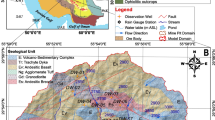Abstract
According to the engineering features of the proposed power plant and the possible pollution accidents, the accident conditions of two kinds of polluted groundwater, such as the light diesel oil tank bottom leakage and the power plant pond bottom leakage are set up. Using the two-dimensional hydrodynamic dispersion equation of the continuous injection and instantaneous injection, the groundwater pollution in the accident condition is predicted and evaluated. The results show that, with the passage of time, the migration range of groundwater pollutants caused by sewage leakage from industrial wastewater buffer tank shows a trend of gradual expansion; however, the maximum value of pollutant concentration exceeding standard is gradually decreasing. After 10 years, the excessive pollutant migration distance has reached 390 m. If no remedial measures are taken in time, during the operation of the power plant, industrial wastewater pool sewage leakage will cause long-term pollution to the groundwater. Similarly, if the accident was diesel tank explosion, the range of diesel contamination to groundwater is also increasing over time, but the concentration of pollutants is gradually decreasing. About 25 years later, the pollutant concentration within 400 m downstream of pollution source has decreased to 0.04 mg/L, and the impact of diesel oil leakage on groundwater has largely disappeared.










Similar content being viewed by others
References
Aral MM, Liao B, Member ASCE (1996) Analytical solutions for two-dimensional transport equation with time-dependent dispersion coefficients. J Hydrol Eng 1(1):20–32
Chen C, Xu Z, Shi P et al (2011) Research and application of power plant accidental sewage buffer pool construction. Water Resour Power 29(7):149–152
Du L, Fu Q, Cheng C et al (2003) 2D seepage flow and contaminant transport modeling for groundwater. Water Power 29(4):19–23
Fang Y, Luo Y, Hou Y et al (2013) Pollution characteristics of shallow groundwater in Jiaozuo. Appl Mech Mater 295–298:1580–1585. https://doi.org/10.4028/www.scientific.net/AMM.295-298.1580
Fried JJ (1975) Groundwater pollution. Elsevier Scientific Publishing Company, Amsterdam
General Administration of Quality Supervision, Inspection and Quarantine of P.R.C (1994) Quality standard for ground water (GB/T14848-93). China Standards Press, Beijing
Han D, Currell MJ, Cao G (2016) Deep challenges for China’s war on water pollution. Environ Pollut 218(218):1222–1233
Huang T, Fan J, Zhang D (2013) Analytical prediction under accident conditions typical beneficiation project environmental impact on groundwater. Gansu Metall 05:128–130
Hunt BW (1978) Dispersive sources in uniform groundwater flow. ASCE J Hydraul Div 104(HY1):75–85
Jin Y, Qiu J, Qiu G et al (2016) Research on groundwater environment quality evaluation basing on the analytical method. Groundwater 38(5):83–86
Li T, Li L, Song H et al (2016) Evaluation of groundwater pollution in a mining area using analytical solution: a case study of the Yimin open-pit mine in China. SpringerPlus 5:392
Liu T, Xiao C, Wang Y et al (2015) Research of groundwater solute transport forecast based on analytical method. Water Sav Irrig 2:47–49
Liu Z, Yang J, Zhou Q (2016) Comparative Analysis on prediction results by using numerical method and analytical method of solute transport in groundwater. Land Resour Shandong Prov 32(7):78–82
Ministry of environmental protection of the People’s Republic of China (1997) Integrated wastewater discharge standard (GB8978-1996). China Environmental Science Press, Beijing
Ministry of environmental protection of the People’s Republic of China (2016) Technical guidelines for environmental impact assessment-groundwater environment (HJ 610-2016). China Environmental Science Press, Beijing
Nalawade PM, Bholay AD, Mule MB (2012) Assessment of groundwater and surface water quality indices for heavy metals nearby area of Parli thermal power plant. Univ J Environ Res Technol 2(1):47–51
National Health and Family Planning Commission of the PRC (2007) Standards for drinking water quality (GB5749-2006). China Standards Press, Beijing
Sauty JP, Pierre J (1980) Analysis of hydro-dispersive transfer in aquifers. Water Resour Res 16:145–158
Verma C, Madan S, Hussain A (2016) Heavy metal contamination of groundwater due to fly ash disposal of coal-fired thermal power plant, Parichha, Jhansi, India. Cogent Eng 3:1179243
Wang H (2008) Dynamics of fluid flow and contaminant transport in porous media. Higher Education Press, Beijing
Wang H, Wu H (2009) Analytical solutions of three-dimensional contaminant transport in uniform flow field in porous media: a library. Front Environ Sci Eng China 3(1):112–128
Wang L, Zhang B, Qu Q et al (2007) Modeling on groundwater contamination by oil from pipeline seepage and breakage. J Lanzhou Univ (Natural Sciences) 43(1):29–32
Wang Z, Zhang X, Su Q (2013a) The application of analytical method for solute transport in the environmental impact assessment of groundwater. Sci Technol Inf 29:141–142
Wang S, Wang H, Han Z et al (2013b) Thermal power plant technology and methods of environmental impact assessment of groundwater discussion. Environ Sustain Dev 6:72–75
Wei H, Xiao H (2013) Advances in groundwater solute transport simulating research. J Glaciol Geocryol 35(6):1582–1589
Wilson JL, Miller PJ (1978) Two-dimensional plume in uniform ground-water flow. ASCE J Hydraul Div 4:503–514
Yanqing W (2012) Mathematical model of flow and contaminant transport in porous media. Science Press, Beijing
Yin Y, Liu D, Li J et al (2011) Research progress of groundwater pollution prevention in China. Environ Sci Manag 36(6):27–30
Zhu W, Zhang Y (2013) Risk prediction of influence on groundwater quality of leakage accidents of power plant. Water Resour Power 31(3):34–36
Author information
Authors and Affiliations
Corresponding author
Additional information
This article is a part of Topical Collection in Environmental Earth Sciences on IV RAGSU—Advances in Geochemistry of the Surface in Argentina, edited by Dr. Americo Iadran Torres and Dr. Pablo Jose Bouza.
Rights and permissions
About this article
Cite this article
Zhao, Y., Zhang, Y., Liu, X. et al. Prediction of groundwater environmental impact on a power plant under accident conditions. Environ Earth Sci 77, 522 (2018). https://doi.org/10.1007/s12665-018-7709-7
Received:
Accepted:
Published:
DOI: https://doi.org/10.1007/s12665-018-7709-7




